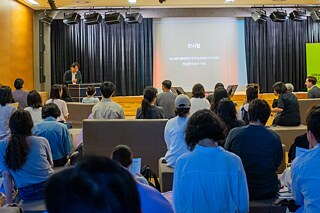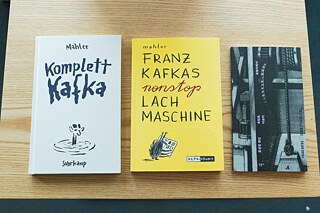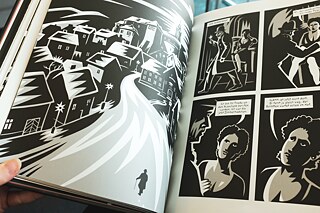Kafka in Art & Talks
Eunhae Joo, the project manager at the Goethe-Institut Korea library, is excited to share valuable tips on how to engage with Kafka's works in an enjoyable way. She also provides information about upcoming events and programs in honor of the 100th anniversary of Kafka's death, along with her personal recommendations from the library collection.
Please briefly introduce yourself and your work at the library of the Goethe-Institut Korea.
My name is Eunhae Joo, and I work as a project manager for events and translation promotion at the Library of the Goethe-Institut Korea. In our library, you can find modern German literature, Korean literature translated into German, photography books, and books on photography, architecture, and art from Korea that are not readily available elsewhere. Our library is mainly frequented by students learning German. Still, it is open to everyone who wants to enjoy the view of Namsan Mountain, study surrounded by plants, or sit comfortably on one of our sofas while reading. I'm always thinking about how to spark more interest in German books among our visitors.

June 3, 2024, was the 100th anniversary of Franz Kafka's death. What's new to learn about Kafka?
This year, to commemorate the 100th anniversary of Franz Kafka's death, we organized several events to encourage people to rediscover his works and learn about him in new ways. One such event was the “Completely Kafka” illustration exhibition, based on the graphic novel of the same name by Austrian illustrator Nicolas Mahler. The exhibition took place at the library of the Goethe-Institut Korea from May to June, offering visitors the chance to see Mahler's works in person.In Korea, Kafka's novels, plays, and films have been widely popular, but graphic novels have been largely unrecognized until now. While Kafka's novels are frequently depicted in Europe, few works in Korea use illustrations to convey his stories. However, Kafka's works are filled with metaphors and symbols, providing artists with ample opportunity for reinterpretation. For instance, in “The Metamorphosis”, the three gentlemen who come to stay with Gregor are described as older men with beards. The reader is left to imagine how these characters look, and artists can further bring the stories to life through their illustrations.
Through this exhibition, you can discover many unknown aspects of Kafka. The exhibition focuses on Kafka's daily life, such as his attention to appearance and clothing, his request to burn most of his writings before his death, and which of his works he found satisfying. Visitors will also learn that Kafka enjoyed going to the movies, despite the common portrayal of him as a depressive person. Additionally, our library features the graphic novel "Komplett Kafka", and other curated graphic novels and novels related to Kafka. To further explore Franz Kafka's work, we have organized a series of lectures with Kafka experts.
Kafka only gave two public readings during his lifetime, one from “In the Penal Colony” and the other from “A Country Doctor”. Due to the current global situation, we have chosen “In the Penal Colony” for our event, as we believe it will provoke thought and discussion. Additionally, on June 14, 2024, five other works were read aloud. The event was moderated by Jeong-hwa Lee, the editor-in-chief of foreign literature at Minumsa, one of Korea's top publishing houses. Author Hyuk-jin Lee (“The Jackal and the Arab”), translator Yeongae Chon (“Before the Law”), poet Cham-Sae Bak (“Unhappiness”), curator Hyun-joo Kim (“The Hunter Gracchus”), and podcaster Hana Kim (“In the Penal Colony”) were all present and effectively conveyed to the audience the emotions, particularly the shock, that Kafka's audience must have experienced.
On June 18, 2024, Professor Seung-Sook Mok from Incheon University, and current president of the Korean Kafka Society, delivered a lecture titled “New Light on Kafka” at the Goethe-Institut Korea library. At the end of June, we concluded our series of events with various lectures on the topic of “Kafka and Graphic Novels”. Professor Sunghwa Kim met with Nicolas Mahler, an Austrian cartoonist and illustrator, and Renata Puchkova, a Czech illustrator, at our event. They discussed different stories and presented the process of reinterpretation through images of Kafka's life and works.

The events featured not only illustrations from Nicolas Mahler's poster exhibition but also extensive Kafka content, including graphic novels. What is the reason for this?
Franz Kafka left behind numerous drawings, self-portraits, and sketches of people, including his mother. In one of his letters to his fiancée Felice Bauer, he asked, “How do you like my pictures? My dear, I was once a great draughtsman.” When unable to describe a particular scene in words, Kafka would draw it himself and send it to Felice Bauer. This shows that for Kafka, both letters and pictures were important forms of self-expression. His novels, especially his short stories, are often abstract and contain metaphors, symbols, and passages that prompt reflection. Because of this, they are some of the most discussed and interpreted works in various media, such as films, plays, musicals, paintings, etc. Kafka's life and novels have been reinterpreted and presented in graphic novels as well.When adapting writings into other forms of media, it's not essential to faithfully reproduce the content. For instance, when Kafka's works were adapted into graphic novels, the focus wasn't on simply adding illustrations to his writings. Instead, it was more important to create new content that aligned with the historical context and personal interpretation of the author or illustrator. As a result, each graphic novel presents the stories and images uniquely and differently from one another.

I highly recommend watching the videos from "Sommer's World Literature to Go" that retell Kafka's works using Playmobil figures. If you've found Kafka's works difficult to understand due to the misconception that they are too complex, challenging, or lengthy, Mr. Sommer's Playmobil adaptations demonstrate that Kafka's writings can be reimagined in an accessible and humorous way.
What Kafka-related books do you recommend that are available in the library?
I'd like to recommend three graphic novels or picture books that focus on images rather than text and delve into the life and works of Franz Kafka.

“Kafka” by David Zane Mairowitz and Robert Crumb provides a detailed documentary-style look at the historical background and the Jewishness of Prague during Kafka's time. “Komplett Kafka” by Nicolas Mahler uses a simple, cute drawing style in a compressed comic format, allowing for quicker and more intuitive consumption of the content. It's worth noting that Mahler's drawing style is said to be the most similar to Kafka's famous drawings. Lastly, “Franz Kafka: Known or Secret” by Renáta Fučíková and Radek Malý features essential images of Prague for understanding Kafka and also artistic illustrations that express Kafka's strange and dark atmosphere. These works provide a unique insight into how American, Austrian, and Czech writers interpreted and expressed Kafka's life and writings.
The book I want to introduce is “The Castle”, which I found very impressive. Before reading the novel, I recommend checking out the graphic novel version by David Zane Mairowitz and Jaromir 99. Then, it would be beneficial to compare how the content is expressed through text and pictures. As I mentioned before, with graphic novels, you can see that the content of the novel is interpreted and designed differently according to the re-interpretation and creation of the graphic novel author and illustrator. Instead of simply adding illustrations to Kafka's text, graphic novels use a narrative style that stimulates visual imagination and expands on the content beyond the text.

Franz Kafka's works can be interpreted from various perspectives, including religious, literary, philosophical, and psychoanalytic. They have a depth that transcends his time and can be appreciated by today's readers. On the occasion of the 100th anniversary of Kafka's death, I encourage you to explore not only Kafka's literature but also the graphic novel adaptations of his work. I also recommend that you interpret Kafka from your perspective.
